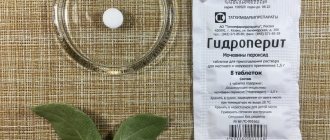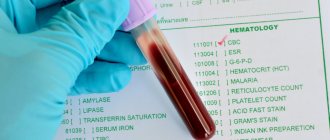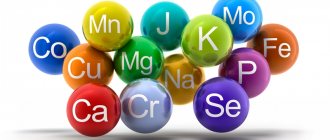Many of us, when thinking about beneficial microelements and minerals, first of all talk about calcium, iron or another advertised nutrient. People who are more careful about their diet may recall the benefits of foods containing, for example, zinc or magnesium. But there are many substances whose properties are less known, but they play a vital role for the body. One of these is manganese.
Biological role of manganese
The functions of manganese in the human body are mainly due to the fact that the element is part of the structure of enzymes that catalyze certain biochemical reactions:
• Constitutes the active centers of liver enzymes, which are responsible for the neutralization and removal of certain toxic metabolic products from the body • Part of the enzymes responsible for tissue respiration • Is an integral part of substances that regulate the formation of connective tissue elements, maintains the elasticity of cartilage and bone density • Participates in the production of pancreatic hormones (synthesis of its hormones) • Increases the performance of the nervous system, improves signal transmission in the white matter • Provides muscle function • Takes part in the processes of production and consumption of energy in the body • Promotes full protein metabolism • Has a protective effect on the liver • Reduces glucose content in the blood, improving its absorption by tissues • Indirectly participates in blood coagulation processes • Increases the functional activity of the thyroid gland • If, simultaneously with adequate dosages of manganese, the body receives enough copper and zinc, then it exhibits better antioxidant properties. In this capacity, the element has a general health-improving and rejuvenating effect. • Has a beneficial effect on the absorption of B vitamins, and enhances their positive effects in the body.
References
- Aschner, M., Erikson, K. Manganese. Adv Nutr., 2021. - Vol. 8(3). — P. 520-521.
- Horning, K., Caito, S., Tipps, K. et al. Manganese Is Essential for Neuronal Health. Annu Rev Nutr., 2015. - Vol. 35. - P. 71-108.
- Michalke, B. Review about the manganese speciation project related to neurodegeneration: An analytical chemistry approach to increase the knowledge about manganese related parkinsonian symptoms. J Trace Elem Med Biol., 2021. - Vol. 37. - P. 50-61.
Signs of manganese deficiency
A deficiency of the mineral occurs quite rarely, and additional use of manganese is not necessary for many people. However, if a person experiences disorders of the pancreas, thyroid, or gonads, then he should think about restoring the normal content of manganese in the body.
Anemia, a tendency to fractures, and delayed growth and development in children may also be associated with a deficiency of the element. In adults, chronic deficiency of the mineral is associated with accelerated aging, increased morbidity, an increased risk of developing allergies and even, possibly, cancer.
Sources in food
Many healthy foods contain reserves of manganese. In particular, excellent sources of this trace element include grains, legumes, vegetables and fruits.
Most of them contain almost 100% daily value of Mn in just 1 serving. For example, 100 g of oatmeal contains within 96% of the daily value of manganese.
The mineral is preserved relatively well in food products. After cooking, most manganese remains in legumes (minor losses of the microelement are noted during heat treatment). A little more of the nutrient is lost in other vegetables when exposed to high temperatures. However, the level of wastage can be easily reduced by minimizing cooking time and contact with water. For example, if spinach is cooked briefly, manganese losses will be reduced by approximately 10 percent.
Signs of excess manganese
Currently, excess manganese levels in the body are rare. Previously, it was observed more often and was detected in ore mining workers, as well as in employees of enterprises whose activities involved the use of manganese-containing compounds. In the absence of proper protection (safety precautions were not always given enough attention), people developed severe health problems. For example, manganese rickets was encountered - fragility and softening of bones due to a violation of their structure.
Excess manganese in the body can also lead to symptoms reminiscent of poisoning with heavy metal salts. Workers of a number of enterprises, as well as welders (welding aerosol contains a lot of manganese) should be very careful!
To avoid an excess of the mineral, you should not use manganese in doses higher than 11 mg per day. The toxic dose is 40 mg per day.
How to create a menu rich in manganese
There are not so few sources of Mn among natural foods. Therefore, even with an acute deficiency of micronutrients, it is not difficult to create a menu of food rich in useful elements. Do you want to increase the concentration of a mineral in the body? Then the recommendations of nutritionists will help you choose the right products for your daily diet.
Sample menu
Breakfast. An excellent option for a morning meal is oatmeal with fresh raspberries. Both products contain high amounts of manganese.
Dinner. Preparing a hearty and tasty lunch rich in manganese is not a problem, since almost all vegetables contain this element. Green bean soup or beetroot soup (beets are the richest source of Mn) are suitable as the first hot dish. This nutrient is found in the ingredients of most soups: carrots, onions, garlic and others. For the second course, prepare rice (ideally brown) with beef and a salad of leafy vegetables with soy sauce as a side dish. Finish the meal with dessert - fresh strawberry or grape juice.
Dinner. To end the day, you can treat yourself to vitamin-rich spinach with buckwheat, or a vegetable or fruit salad. Before bed, drink a cup of mint or lemon balm tea.
Throughout the day, different types of nuts (almonds, hazelnuts, peanuts, pistachios, coconut), fruits and berries (figs, kiwi, bananas, pineapples and all tropical fruits, blackberries, strawberries) are suitable as healthy snacks.
Table of manganese content in food
| The product's name | Product quantity | Amount of manganese (mg) |
| Hazelnut | 200 g | 8,4 |
| Pistachios | 200 g | 7,6 |
| Peanut | 200 g | 3,82 |
| Soybeans | 200 g | 2,84 |
| Barley | 200 g | 2,39 |
| Wheat | 200 g | 2,22 |
| Spinach | 200 g | 1,82 |
| Beet tops | 200 g | 1,48 |
| A pineapple | 200 g | 1,46 |
| Mushrooms | 200 g | 1,22 |
| Chard | 200 g | 1,16 |
| Beet | 200 g | 1,1 |
| Rosehip (dried) | 200 g | 1 |
| Potato | 200 g | 0,76 |
| Brussels sprouts | 200 g | 0,7 |
| Onion | 200 g | 0,64 |
| Broccoli | 200 g | 0,6 |
| Strawberry | 200 g | 0,56 |
| Asparagus | 200 g | 0,56 |
| Cabbage | 200 g | 0,54 |
| Apricot | 200 g | 0,44 |
| Tomatoes | 200 g | 0,42 |
| Carrot | 200 g | 0,34 |
| Cauliflower | 200 g | 0,32 |
| Eggplant | 200 g | 0,22 |
| Celery | 200 g | 0,2 |
| Cucumber | 200 g | 0,16 |
| Brown rice | 1 glass | 1,76 |
| Chickpeas | 1 glass | 1,69 |
| Lentils | 1 glass | 0,98 |
| Raspberries | 1 glass | 0,82 |
| Green pea | 1 glass | 0,72 |
| Buckwheat | 1 glass | 0,68 |
| Blueberry | 1 glass | 0,50 |
| Millet | 1 glass | 0,47 |
| Green bean | 1 glass | 0,36 |
| Cranberry | 1 glass | 0,36 |
| Rye | 0.5 cups | 1,44 |
| Basil | 0.5 cups | 0,24 |
| Dill | 0.5 cups | 0,06 |
| Oats | 0.25 cups | 1,92 |
| Pumpkin seeds | 0.25 cups | 1,74 |
| Walnuts | 0.25 cups | 1,02 |
| Sesame | 0.25 cups | 0,89 |
| Sunflower seeds | 0.25 cups | 0,68 |
| Cashew nuts | 0.25 cups | 0,66 |
| Almond | 0.25 cups | 0,53 |
| Mint | 2 tbsp. l. | 0,9 |
| Soy sauce | 1 tbsp. l. | 0,09 |
| Carnation | 2 tsp. | 2,53 |
| Cinnamon | 2.h. l. | 0,91 |
| Black pepper | 2 tsp. | 0,74 |
| Garlic | 6 cloves | 0,30 |
| Banana | 1 medium | 0,32 |
| Corn | 1 head of cabbage | 0,13 |
| Figs | 1 medium | 0,06 |
Nutritional deficiency
A typical diet for “meat eaters” contains approximately 2-7 mg of manganese per day. But “herbivores” are able to provide themselves with almost 10 mg of the element daily (the norm is 5-10 mg/day). Therefore, it is very difficult to achieve Mn deficiency by eating a varied menu rich in vegetables. And most of the products from our daily table are excellent sources of manganese.
But we should not exclude the possibility of developing Mn deficiency, which can be caused by a variety of health problems (the most common is impaired absorption of nutrients).
Most likely, a person does not get enough manganese from food if:
- signs of hypertension appeared;
- heart function has worsened;
- bones hurt;
- cholesterol increased;
- Vision, hearing and memory deteriorated.
A very severe deficiency of the mineral can lead to female infertility, osteoporosis, pancreatic cancer, and cardiac problems.
Products containing manganese
If manganese is so important for the human body, then from what products can it be obtained? You can find them on the shelves of most ordinary supermarkets. However, it is worth remembering that the maximum concentration of manganese is found only in unrefined, natural products that were produced without the use of heat treatment.
Products of animal origin contain a minimal amount of this substance, which makes it impossible to compensate for its deficiency in the body. Manganese contains:
- in all types of meat, except pork;
- in the kidneys;
- in fish;
- in crustaceans;
- in cheese.
Large concentrations of the substance are found in products of plant origin:
- in olive oil;
- in fruits – grapes and lemon;
- in vegetables - cabbage, carrots, cucumbers, radishes;
- in legumes – peas, beans;
- in greens - parsley and dill;
- in cereals - rye, wheat, millet, buckwheat, oatmeal, rice;
- in berries - lingonberries, bird cherry, blueberries, strawberries, raspberries, black currants;
- in honey;
- in cocoa;
- in tea;
- in nuts.
Methods for removing manganese from water
Manganese aeration
This method is very affordable and therefore the most common. Serious aeration of manganese is carried out, then filtration. First, free carbon dioxide is separated from water under vacuum, which increases the pH level to 8.0–8.5 units. After this, it’s the filter’s turn to work. It is used as a granular filler, for example, quartz sand.
However, this method is not suitable for all cases. It is not used if the permanganate oxidation of water is more than 9.5 mgO2/l. To use this method, the presence of divalent iron in the water is required, which, upon oxidation, turns into iron hydroxide. It, in turn, absorbs divalent manganese and oxidizes it. Another condition: compliance with a strict ratio between manganese and ferrous iron - seven to one. However, the last point can be artificially corrected by adding iron sulfate to the water.
Catalytic oxidation
Manganese tetravalent hydroxide (formed on the filter surface by the metering pump) oxidizes manganese divalent oxide. The resulting trivalent oxide is oxidized with the help of dissolved oxygen to a water-insoluble state.
Demanganation with potassium permanganate
Can be used to purify both underground and external waters. Potassium permanganate oxidizes manganese dissolved in water, turning it into an oxide, which is much less soluble in water. Manganese oxide, in turn, is a good catalyst for dissolving divalent manganese. To get rid of 1 mg of the latter, you need 1.92 mg of potassium permanganate. At this ratio, 97 percent of divalent manganese will be oxidized.
After this, the water must be filtered using a special coagulant, then additional sand filler is used. Sometimes ultrafiltration equipment is also used.
Introduction of oxidizing reagents
Various reagents are used to oxidize manganese in water. But mainly it is chlorine, its dioxide, sodium hypochlorite and ozone. It is very important to take into account the pH level of the water. If you add chlorine to water with a pH value of at least 8.0–8.5, you will have to wait about an hour and a half for a good effect. Sodium hypochlorite also acts for the same time. Often the treated water needs to be alkalized. This is done in cases where oxygen acts as an oxidizing agent and the pH of the water does not reach 7 units.
Calculations show that to convert divalent manganese into tetravalent manganese, 1.3 mg of reagent substance must be taken per mg of manganese. But this is just in theory; in practice, much more oxidizing agent is usually required.
Chlorine dioxide or ozone acts much faster when treating water - only about a quarter of an hour. True, only if the pH of the water is 6.5–7.0 units. According to stoichiometric calculations, 1 mg of divalent manganese will consume 1.35 mg of chlorine dioxide or 1.45 mg of ozone. But again, more ozone will be required than in theoretical calculations. This happens because during the ozonation process, manganese oxides decompose ozone.
In general, there are several reasons why more reagents are required than indicated in the calculations. The process of manganese oxidation in water is influenced by many factors. For example, this is the pH level of water, the presence of organic matter in it, and the duration of action of the reagents used. A lot depends on the equipment used for the process. Practice shows that potassium permanganate usually needs to be taken 1–6 times more, ozone – 1.5–5 times, and chlorine oxide may even need 1.5–10 times more.
Ion exchange
Ion exchange involves hydrogen or sodium cationization of water. To effectively remove manganese salts dissolved in water, it must be treated in two layers of ion-exchange material. For this, two resins are used: cation exchange with hydrogen ions H+ and anion exchange with hydroxyl ions OH-. They are used simultaneously and sequentially. This mixture of resins replaces water-soluble salts with hydroxide OH- and hydrogen ions H+. When these ions combine, the most common water molecules are obtained without the presence of salt in them.
At the moment, this method of removing manganese and iron impurities from water is the most promising. The main thing is to choose the right combination of ion exchange resins.
Distillation
This method is based on the conversion of water into steam and its subsequent concentration. Everyone has long known that the boiling point of water is 100 °C. But this does not mean that it will be the same for other substances. This method of purifying water from manganese is based on the difference in boiling temperatures. Pure water boils first and turns into steam. Other elements evaporate only after most of the water has boiled away. Thus, we obtain clean water, without impurities. The technology is simple and understandable to everyone, but very energy-consuming.
Gynecological problems and infertility
Manganese supports the production of estrogen and other sex hormones. If there is a lack of it, the hormonal balance is disrupted, which threatens infertility, sudden termination of pregnancy, and an increased risk of gynecological inflammation. An early onset of menopause is noted.
A lack of manganese during pregnancy is especially dangerous: it is fraught with various pathologies of the fetus, including underdevelopment of the neural tube. You cannot self-medicate; the required dose of medications containing magnesium must be determined by a gynecologist.
Prevention of microelementosis
Replenishing your supply of essential microelements is not so difficult. It is important to pay attention to a balanced and varied diet, which should contain a lot of natural plant foods. In addition, physical activity, frequent exposure to fresh air and protection from stress are necessary.
Sources:
- Neuroendocrine disorders of human ontogenesis of environmental etiology and their rehabilitation therapy. Kozhin A.A., Zhukov V.V., Popova V.A. Bulletin of new medical technologies. Electronic edition, 2021 No. 1.
- Biological role and significance of microelements in human life. Kanzhigalina Z.K., Kasenova R.K., Oradova A.Sh. Bulletin of the Kazakh National Medical University, 2013 No. 5.
Filters for purifying water from manganese
In this case, choosing filters is not so easy. Here you should act according to the system. First, determine the composition of the water that needs to be purified from manganese. Secondly, identify the minimum requirements for water quality after filtration. Thirdly, when choosing a cleaning system you need to pay attention to the following points:
- What is the content of iron and manganese in water;
- To the pH level of the water;
- The amount of oxygen or carbon dioxide in water;
- Is there ammonia or hydrogen sulfide in the water?
- The characteristics of the water supply system are also important: its performance and water pressure.
After this, you can begin to select a filter material to purify water from manganese. There are several of them that are the most popular.
SUPERFEROX
SUPERFEROX filter material is designed to remove iron and manganese ions dissolved in water, as well as reduce the turbidity and color of water. The basis of the filter medium is a durable natural material “pink sand” with a catalytic film consisting of higher manganese oxides applied to its surface. The action of SUPERFEROX is based on 2 principles: sorption (due to the porous structure of the material) and catalytic oxidation. When filtering water, manganese oxides present in the catalytic film accelerate the process of oxidation of divalent iron to trivalent iron with the formation of the corresponding hydroxide. Due to the porosity of the material structure, the formation of ferric hydroxide occurs both on the surface of SUPERFEROX grains and inside its pores, which leads to an increase in dirt holding capacity and acceleration of the process of iron removal from water. The resulting iron hydroxide is capable of catalytically oxidizing divalent manganese to form practically insoluble hydroxides Mn(OH)3 and Mn(OH)4. When the filter resource is exhausted, in order to restore the properties of the filter medium, it is necessary to regenerate the installation with a reverse flow of original or purified water (more efficiently, with a water-air mixture).
Ferosoft B
The multicomponent ion exchange charge FeroSoft was created for a comprehensive solution to problems in water treatment systems. This load consists of several ion exchange resins of different granulometric compositions that make it possible to effectively remove hardness salts (Ca2+ and Mg2+), iron impurities (Fe3+ and Fe2+), manganese (Mn2+), and organic compounds from the source water. The load is designed to solve the most typical problems with drinking water, and is most suitable for use in water treatment systems of country houses and cottages.
Read material on the topic: How to choose a water filter for an apartment or private house
Increased fatigue
Manganese affects the synthesis of thyroxine, a thyroid hormone. Its lack leads to rapid fatigue, sleep problems, and sudden mood swings. The situation worsens with nervous overload, stress, and constant mental tension.
In this state, the body actively consumes manganese, exacerbating its deficiency. The situation worsens if a person does not receive other important components:
- copper,
- zinc,
- selenium,
- chromium.
Deterioration of skin, hair and nails
When using certain medications and an unbalanced diet, the daily dose of manganese entering the body drops to a critical minimum.
With prolonged deficiency, changes in the skin are noticeable. Hyperpigmentation occurs, especially noticeable in open areas, increased dryness of the skin, dermatitis, and small scaly rash.
Nails peel and break, naturally dark hair takes on a reddish tint.
Dizziness
Manganese deficiency interferes with the absorption of other important elements. With an insufficient amount of iron, a person suffers from dizziness, accompanied by nausea, vomiting, and temporary loss of orientation in space. The condition is worsened by lack of sleep and uncontrolled use of painkillers.
A balanced menu that includes foods rich in manganese will help restore the balance of macroelements:
- various nuts,
- legumes,
- potato,
- Rye bread,
- bran.
You should not give up tea and coffee, and the amount of alcohol should be sharply limited.
Symptoms of micronutrient deficiency
Although only laboratory tests and examination by a doctor can accurately determine the imbalance of microelements, there are a number of signs of a lack of microelements in the body - frequent infections, weakened immunity, deterioration in appearance (problems of nails, skin or hair), irritability, drowsiness.
In addition, there are a number of manifestations that are associated with an imbalance of certain microelements.
- Excess weight, which is difficult to combat, is possible due to a lack of manganese, zinc or chromium.
- Digestive disorders are possible due to a lack of chromium or zinc.
- Disorders of the intestinal microbial flora can occur with zinc deficiency.
- Allergy to food – deficiency of zinc, selenium.
- Prostate dysfunction – deficiency of selenium, zinc, iodine.
- Increased blood sugar - problems with the supply of chromium, zinc, manganese, molybdenum.
- Brittle nails, split ends - deficiency of iron, zinc, copper.
- Hair loss – lack of zinc, selenium.
- Pigmentation on the skin – deficiency of copper, selenium or manganese.
- Acne on the face and body - lack of selenium, copper, zinc.
How to find out which microelements the body lacks
There are a number of laboratory tests that can determine both macronutrient deficiencies (calcium, magnesium, potassium) and micronutrient deficiencies. Blood, urine, nails, and hair are taken for testing. Spectral analysis of hair can quite accurately determine which microelements the body lacks.
How to take missing microelements correctly
Before taking complexes of vitamins with microelements, you need to consult a doctor and determine that all the problems of the body are precisely an imbalance of vitamins and minerals, and not any diseases. Source: Neuroendocrine disorders of human ontogenesis of environmental etiology and their restorative therapy. Kozhin A.A., Zhukov V.V., Popova V.A. Bulletin of new medical technologies. Electronic edition, 2021 No. 1..
Obesity
An imbalance of minerals interferes with the normal absorption of food, and disruption of neural connections blocks the feeling of fullness. As a result, a person constantly overeats, which quickly affects body weight.
A lack of manganese increases blood sugar levels, and there is a risk of developing type II diabetes. The macroelement affects the rate of deposition of subcutaneous and visceral fat and prevents the growth of fat cells in liver tissue.
Manganese deficiency threatens weight gain, even if the number of kilocalories is within normal limits.
How is water purified from manganese?
To begin with, specialists analyze the water for manganese concentration, and only after that choose the most suitable method of purifying it.
Manganese in earth rocks is most often found in the form of a salt, which is highly soluble in water. Therefore, in order to purify water from manganese, it is necessary to ensure that this element ceases to be soluble. This is where chemistry comes to the rescue. Divalent manganese is converted to trivalent or tetravalent manganese by oxidation. Manganese hydroxides with valency 2 and 3 are almost insoluble in water.
There are several methods for oxidizing manganese:
- With the help of strong oxidizing agents that increase the redox potential of the environment. At this value, the pH of the water is not regulated.
- Weak oxidizing agents are used while simultaneously increasing the pH value of the water.
- They increase the pH value of water using strong oxidizing agents.
Divalent manganese is converted into tetravalent manganese hydroxide and deposited on the filters. In addition, it itself turns into a catalyst, which accelerates the oxidation process of divalent manganese remaining in the water with the help of dissolved oxygen.
Read material on the topic: Reverse osmosis system: how to choose and install
Medicines containing manganese
For therapeutic purposes, doctors can prescribe the drug Turamine, which contains 25 mg of the substance in one tablet, for manganese deficiency. Also contain manganese and multivitamin complexes, such as:
- "Vitrum";
- “Calcemin Advance”;
- “Complivit”;
- “Maxamine Forte”;
- “Multi-tabs”;
- “Oligovite”;
- “Supradin.”










